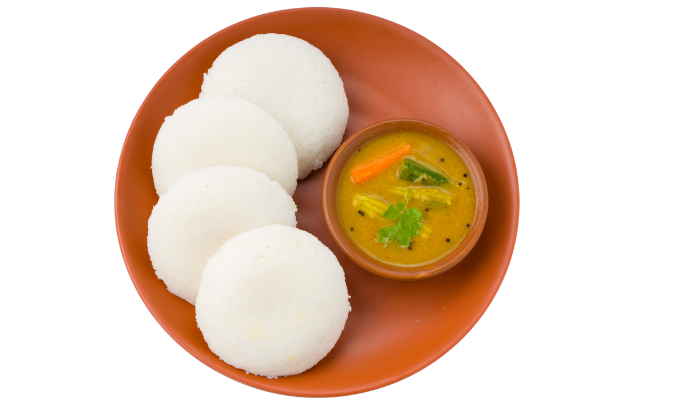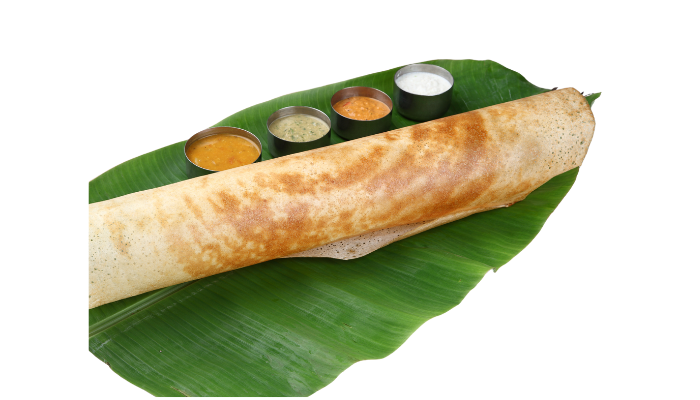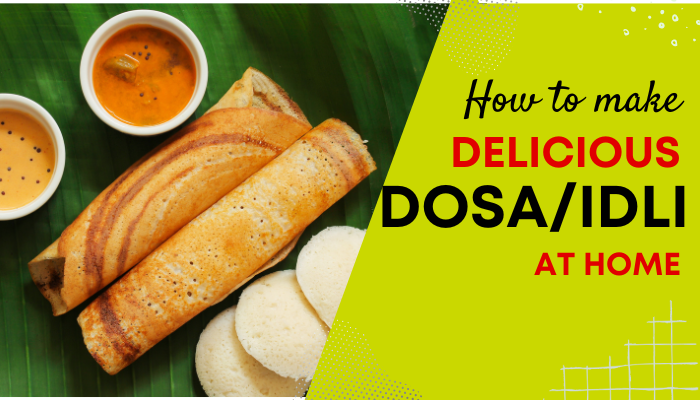Dosa and Idli, originally from Tamilnadu, have become beloved breakfast staples in Kerala. Perfecting the art of making cripsy dosas and fluffy idli requires true mastery.
Preparation of Dosa/Idli Batter
Ingradients
- Idli rice – 1 kg
- Blackgram dal – 300 to 320 gm
- Salt – 2 ½ to 3 tbsps
Method
Wash and clean the rice and dal separately and soak in water for 2 to 3 hours in separate vessels. After 2 hours wash the dal again, drain and grind well preferably in a wet grinder. Add ½ a litre of water now and then keep grinding for about one hour. The blackgram dal when ground, froths up and increases in volume tremendously.

The batter feels very light. Pour this batter into a big steel vessel, the blackgram batter will measure about 2 ½ litres. Grind the soaked rice in the same way adding ½ a litre of water now and then. The rice for idli need be ground only for 40 to 45 minutes, the batter need not be too fine.
However, for dosa the soaked rice must be ground for 50 to 55 minutes or at the most one hour. Remove the rice batter and mix it with the black gram batter thoroughly after adding salt. The total volume will come to about 4 to 4 ½ litres. Keep closed at room temperature for 12 to 14 hours and leave to ferment.
The batter froths up and feels lighter. Stir well and add a little more water if needed. Transfer to an airtight container and keep in one of the shelves of the refrigerator for later use. This is a standby for hungry guests who might turn up at any time and can also be used the next day.

Idli Making
Idli is made with the batter thus prepared. Idlis have to be made in the special idlipathram which is available in shops, amazon and flipkart. It is a vessel made of aluminium or brass and has two or three shelves with shallow depressions. Smear a little til oil in each of the depressions and pour the idli batter into each of the depressions.
Each must be filled only up to three fourth of the depression. Steam it for about 8 to 10 minutes and then remove from flame. Take the shelves out and allow to cool for about one or two minutes. Each idli must be slid out using a wet spoon. Now it is ready to be served.
A quality idli must have the following features:
- It should be very soft and very light.
- It should be easily broken with just the forefinger and the thumb.
- It should have the typical idli flavour.
- It should float on water.
- It should rise and fill the depression.
Idlis are easily digestible and therefore fit for patients and convalescents. Idlis can be relished with saambaar, chutney, ulli chammanthi, stew and even with rasam.
Remember not to add yeast or boiled rice paste to help fermentation. The micro-organisms perform the magic when the batter is kept at room temperature between 30 to 32, 34 degrees.
Dosa Making
Dosas are made from the same batter as idli though its consistency is a little thinner. Dosas are made on the dosa griddle. One tablespoon of til oil/gingelly oil/ sesame oil/nallenna is also needed. Quality dosas are made on a dosa griddle which is a thick, flat, square or round iron sheet.
Though a large variety of non stick griddles are available, they are all thinner than the iron dosa griddle and do not retain heat. On the other hand they get hot and cold quickly and as a result the uniform cooking of the dosa does not take place.
A truly tasty dosa can be made only when it is cooked on an iron dosa griddle which becomes hot slowly, retains the heat and releases it slowly. The resultant dosa will be slightly reddish on both sides.

Heat the griddle and then apply a drop of oil on the hot surface. Pour a ladle of the batter into the centre of the hot griddle and then spread it outwards into a round shape. The thickness of the dosa is one’s own preference.
Bubbles are formed on the surface of the dosa thus indicating that it is half cooked. Flip it over and allow this side to be cooked. When the colour is slightly reddish the dosa is done and can be relished with chutney, saambaar, onion chutney etc.
It is best to use an iron dosa griddle for good results. Do not spread the batter in the anticlockwise direction and do not touch the dosa while it is cooking on the hot griddle.
